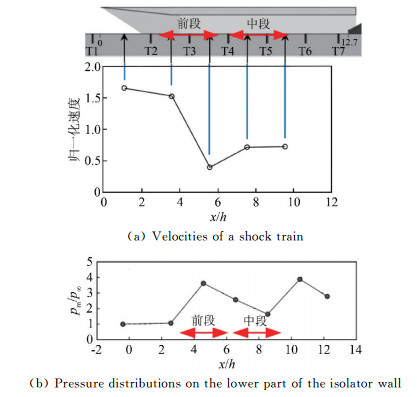Recent research progress on motion characteristics and flow mechanism of shock train in an isolator with background waves
-
摘要: 对高超声速进气道-隔离段激波串在复杂背景波系下的突跳运动特性及其流动机理的最新研究进展进行了综述,涵盖了背景波系作用下的激波串运动特性、突跳机理和突跳运动特性的数学描述方法,以期对高超声速进气道相关研究工作提供一定的参考。首先,对固定背景波系和变化背景波系下的激波串运动特性和突跳机制进行阐述,指出隔离段壁面压力顺压力梯度和逆压力梯度的交替变化是激波串突跳特性产生的内在物理机制。其次,对背景流场下隔离段激波串突跳运动的触发机理和触发条件进行了讨论。最后,基于对运动特性和突跳机制的认识,尝试给出了背景波系作用下的隔离段激波串运动特性的数学模型,为激波串前缘位置控制提供参考。Abstract: The present paper aims to provide a summary report on recent research progress about motion characteristics and flow mechanism of a shock train in a hypersonic inlet-isolator with complex background waves to help the researchers working on hypersonic inlet-isolator easily with their further work. It covers shock train motion characteristics, mechanism of a shock train jumps, and the method for the model of a shock train jumps with complex background waves. At first, the investigations for the motion characteristics of shock train with fixed or variable background waves are described, which point out that the boundary layer separation caused by the alternating favorable or adverse pressure gradient in the isolator is the physical mechanism of the shock train motion characteristics. Followed, the triggering mechanism and condition of shock train jumps in an isolator with background waves are discussed. At last, based on the understanding of the motion characteristics and jump mechanism, the method for the mathematical model of the shock train motion in an isolator with background waves is given to provide a reference for the control of the shock train leading edge.
-
Key words:
- background waves /
- shock train /
- jump characteristics /
- flow mechanism /
- mathematical model
-
表 1 激波串运动过程的激波串前缘收缩比测量值[27]
Table 1. Measured values of contraction ratio of the throat-like structure at shock train head[27]
Data No. Motion state Actual CR Explain Correct 1 Rapid motion 0.41 < 0.43 Yes 2 Back to slow 0.50 >0.48 Yes 3 Rapid motion 0.41 < 0.43 Yes 4 Back to slow 0.56 >0.48 Yes 5 Rapid motion 0.41 < 0.43 Yes 6 Back to slow 0.50 >0.48 Yes 7 Rapid motion 0.41 < 0.43 Yes 8 Back to slow 0.51 >0.48 Yes 9 Rapid motion 0.41 < 0.43 Yes -
[1] Curran E T, Heiser W H, Pratt D T. Fluid phenomena in scramjet combustion systems[J]. Annual review of Fluid Mechanics, 1996, 28(1):323-360 doi: 10.1146/annurev.fl.28.010196.001543 [2] Waltrup P J, Billig F S. Structure of shock waves in cylindrical ducts[J]. AIAA Journal, 1973, 11(10):1404-1408. doi: 10.2514/3.50600 [3] Billig F S. Research on supersonic combustion[J]. Journal of Propulsion and Power, 1993, 9(4):499-514. doi: 10.2514/3.23652 [4] 张堃元, 王成鹏, 杨建军, 等.带高超进气道的隔离段流动特性[J].推进技术, 2002, 23(4):311-314. doi: 10.3321/j.issn:1001-4055.2002.04.012Zhang K Y, Wang C P, Yang J J, et al. Investigation of flow in isolator of hypersonic inlet[J]. Journal of Propulsion Technology, 2002, 23(4):311-314. doi: 10.3321/j.issn:1001-4055.2002.04.012 [5] Wang C P, Zhang K Y, Yang J J. Analysis of flows in scramjet isolator combined with hypersonic inlet[R]. AIAA-2005-24, 2005. [6] Wagner J L, Yuceil K B, Valdivia A, et al. Experimental investigation of unstart in an inlet/isolator or model in Mach 5 flow[J]. AIAA Journal, 2009, 47(6):1528-1542. doi: 10.2514/1.40966 [7] Wagner J L, Yuceil K B, Clemens N T. Velocimetry measurements of unstart of an inlet-isolator model in Mach 5 flow[J]. AIAA Journal, 2010, 48(9):1875-1888. doi: 10.2514/1.J050037 [8] 张航, 谭慧俊, 孙姝.进口斜激波、膨胀波干扰下等直隔离段内的激波串特性[J].航空学报, 2010, 31(9):1733-1739. http://d.old.wanfangdata.com.cn/Periodical/hkxb201009005Zhang H, Tan H J, Sun S. Characteristics of shock train in a straight isolator with interference of incident shock waves and corner expansion waves[J]. Acta Aeronautica et Astronautica Sinica, 2010, 31(9):1733-1739. http://d.old.wanfangdata.com.cn/Periodical/hkxb201009005 [9] 田旭昂, 王成鹏, 程克明. Ma5斜激波串动态特性试验研究[J].推进技术, 2014, 35(8):1030-1039.Tian X A, Wang C P, Cheng K M. Experimental investigation of dynamic characteristics of oblique shock train in mach 5 flow[J]. Journal of Propulsion Technology, 2014, 35(8):1030-1039. [10] Tan H J, Sun S, Huang H X. Behavior of shock trains in a hypersonic inlet/isolator model with complex background waves[J]. Experiments in Fluids, 2012, 53(6):1647-1661. doi: 10.1007/s00348-012-1386-1 [11] Huang H X, Sun S, Tan H J, et al. Characterization of two typical unthrottled flows in hypersonic inlet/isolator models[J]. Journal of Aircraft, 2015, 52(5):1715-1721. doi: 10.2514/1.C033190 [12] Koo H, Raman V. Large-eddy simulation of a supersonic inlet-isolator[J]. AIAA Journal, 2012, 50(7):1596-1613. doi: 10.2514/1.J051568 [13] Xu K J, Chang J T, Zhou W X, et al. Mechanism and prediction for occurrence of shock-train sharp forward movement[J]. AIAA Journal, 2016, 54(1):1403-1412. http://www.wanfangdata.com.cn/details/detail.do?_type=perio&id=260709d7c2fe50b58d7bdb3ff4625e54 [14] Li N, Chang J T, Yu D R, et al. Mathematical model of shock-train path with complex background waves[J]. Journal of Propulsion and Power, 2017, 33(2):468-478. doi: 10.2514/1.B36234 [15] Xu K J, Chang J T, Zhou W X, et al. Mechanism of shock train rapid motion induced by variation of attack angle[J]. Acta Astronautica, 2017, 140:18-26. doi: 10.1016/j.actaastro.2017.08.009 [16] Dessornes O, Scherrer D, Novelli P. Tests of japhar dual mode ramjet engine[R]. AIAA-2001-1886, 2001. [17] Denis S R, Kau H P, Brandstetter A. Experimental study on transition between ramjet and scramjet modes in a dual-mode combustor[R]. AIAA 2003-7048, 2003. [18] Chun J, Scheurermann T, von Wolfersdorf J, et al. Experimental study on combustion mode transition in a scramjet with parallel injection[R]. AIAA-2006-8063, 2006. [19] Le D B, Goyne C P, Krauss R H, et al. Experimental study of a dual-mode scramjet isolator[J]. Journal of Propulsion and Power, 2008, 24(5):1050-1057. doi: 10.2514/1.32591 [20] Yu D R, Cui T, Bao W. Catastrophe, hysteresis and bifurcation of mode transition in scramjet engines and its model[J]. Science in China Series E:Technological Sciences, 2009, 52(6):1543-1550. doi: 10.1007/s11431-009-0181-6 [21] Kobayashi K, Tomioka S, Kato K, Performance of a dual-mode combustor with multistaged fuel injection[J]. Journal of Propulsion and Power, 2006, 22(3):518-526. doi: 10.2514/1.19294 [22] Qin B, Chang J T, Jiao X L, et al. Unstart margin characterization method of scramjet considering isolator-combustor interactions[J]. AIAA Journal, 2015, 53(2):493-500. doi: 10.2514/1.J053547 [23] Gnani F, Zare-Behtash H, Kontis K. Pseudo-shock waves and their interactions in high-speed intakes[J]. Progress in Aerospace Science, 2016, 82:36-56. doi: 10.1016/j.paerosci.2016.02.001 [24] Tu Q Y, Segal C. Isolator/combustion chamber interactions during supersonic combustion[J]. Journal of Propulsion and Power, 2010, 26(1):182-186. doi: 10.2514/1.46156 [25] Xu K J, Chang J T, Li N, et al. Preliminary investigation of limits of shock train jumps in a hypersonic inlet-isolator[J]. European Journal of Mechanics-B/Fluids, 2018, 72:664-675. doi: 10.1016/j.euromechflu.2018.07.015 [26] VeillardX, Tahir R, Timofeev E, et al. Limiting contractions for starting simple ramp-type scramjet intakes with overboard spillage[J]. Journal of Propulsion and Power, 2008, 24(5):1042-1049. doi: 10.2514/1.34547 [27] Xu K J, Chang J T, Li N, et al. Experimental investigation of mechanism and limits for shock train rapid forward movement[J]. Experimental Thermal and Fluid Science, 2019, 98:336-345. https://www.sciencedirect.com/science/article/pii/S0894177718303959 [28] Huang H X, Tan H J, Sun S, et al. Evolution of supersonic corner vortex in a hypersonic inlet/isolator model[J]. Physics of Fluids, 2016, 28(12):126101. doi: 10.1063/1.4971448 [29] Funderburk M, Narayanaswamy V. Experimental investigation of primary and corner shock boundary layer interactions at mild back pressure ratios[J]. Physics of Fluids, 2016, 28(8):086102. doi: 10.1063/1.4960963 [30] Pirozzoli S, Grasso F. Direct numerical simulation of impinging shock wave/turbulent boundary layer interaction at Ma=2.25[J]. Physics of Fluids, 2006, 18(6):065113. doi: 10.1063/1.2216989 [31] Bermejo-Moreno I, Campo L, Larsson J, et al. Confinement effects in shock wave/turbulent boundary layer interactions through wall-modelled large-eddy simulations[J]. Journal of Fluid Mechanics, 2014, 758:5-62. doi: 10.1017/jfm.2014.505 [32] Chakravarthy R V K, Nair V, Muruganandam T M, et al. Analytical and numerical study of normal shock response in a uniform duct[J]. Physics of Fluids, 2018, 30(8):086101. doi: 10.1063/1.5027903 [33] Bruce P J K, Babinsky H. Unsteady shock wave dynamics[J]. Journal of Fluid Mechcanics, 2008, 603:463-473. doi: 10.1017/S0022112008001195 [34] Cui T, Wang Y, Yu D R. Bistability and hysteresis in a nonlinear dynamic model of shock motion[J]. Journal of Aircraft, 2014, 51(5):1373-1379. doi: 10.2514/1.C032175 [35] Su W Y, Zhang K Y. Back-pressure effects on the hypersonic inlet-isolator pseudoshock motion[J]. Journal of Propulsion and Power, 2013, 29(6):1391-1399. doi: 10.2514/1.B34803 [36] Li N, Chang J T, Xu K J, Yu D R, et al. Oscillation of the shock train in an isolator with incident shocks[J]. Physics of Fluids, 2018, 30(11):116102. doi: 10.1063/1.5053451 [37] Li N, Chang J T, Xu K J, et al. Prediction dynamic model of shock train with complex background waves[J]. Physics of Fluids, 2017, 29(11):116103. doi: 10.1063/1.5000876 -








 下载:
下载:





























